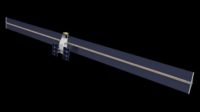Aerospace | News
NASA Awards Northrop Grumman Artemis Contract for Gateway Crew Cabin

NASA has finalized the contract for the initial crew module of the agency’s Gateway lunar orbiting outpost.
Orbital Science Corporation of Dulles, VA, a wholly owned subsidiary of Northrop Grumman Space, has been awarded $187 million to design the habitation and logistics outpost (HALO) for the Gateway, which is part of NASA’s Artemis program and will help the agency build a sustainable presence at the Moon. This award funds HALO’s design through its preliminary design review, expected by the end of 2020.
“This contract award is another significant milestone in our plan to build robust and sustainable lunar operations,” said NASA Administrator Jim Bridenstine. “The Gateway is a key component of NASA’s long-term Artemis architecture and the HALO capability furthers our plans for human exploration at the Moon in preparation for future human missions to Mars.”
The HALO will be the pressurized living quarters where astronauts will spend their time while visiting the Gateway. About the size of a small studio apartment, it will provide augmented life support in tandem with NASA’s Orion spacecraft.
The preliminary design review is one of a series of checkpoints in the design life cycle of a complex engineering project before hardware manufacturing can begin. As the review process progresses, details of the vehicle’s design are assessed to ensure the overall system is safe and reliable for flight and meets all NASA mission requirements.
This cost plus incentive fee contract allows Northrop Grumman to finalize the design of all systems and subsystems. It also provides for the company to award initial subcontracts for long-lead hardware elements. A second contract action is expected to be definitized by the end of the year for Northrop Grumman to fabricate and assemble HALO for integration with the Gateway’s power and propulsion element (PPE) by the end of 2023.
These first two elements of the Gateway – HALO and PPE – will launch together in 2023. This is a recent update to the agency’s plans to build a sustainable presence at the Moon as part of the Artemis program. The decision to integrate the elements on the ground prior to launch – an outcome of the agency’s program status assessment – reduces both cost and technical risks while enhancing the likelihood of mission success by eliminating the need for the two elements to dock in the orbit around the Moon where the Gateway will operate.
“We’re making significant progress on these first two elements, including incorporation of components from ESA (European Space Agency), the Canadian Space Agency, the Japan Aerospace Exploration Agency, and payloads from our research communities,” said Dan Hartman, Gateway program manager at NASA’s Johnson Space Center in Houston. “The new plan to integrate the two elements of Gateway demonstrates the capabilities of the agency and our partners to be flexible and reassess plans as needed. By launching the elements together, we’re able to significantly reduce Gateway’s risk profile and increase cost effectiveness.”
The PPE, being designed and built by Maxar Technologies, is equipped with high-power, 60-kilowatt solar electric propulsion. In addition to providing power and communications, its substantial maneuvering capabilities will allow the Gateway to change orbits and enable crews to reach any part of the Moon’s surface.
Northrop Grumman’s habitation module, developed through NASA’s NextSTEP initiative, is based on its Cygnus spacecraft currently being used to deliver cargo to the International Space Station. The company’s existing production capability and manufacturing assets allow it to build the HALO with limited schedule risk. NASA’s Launch Services Program will select a launch provider for PPE and HALO by late fall 2020.
Charged with returning to the Moon in the next four years, NASA’s Artemis program will reveal new knowledge about the Moon, Earth, and our origins in the solar system. The Gateway is a vital part of NASA’s deep space exploration plans, along with the Space Launch System (SLS) rocket, Orion spacecraft, and the human landing system that will carry astronauts to the surface of the Moon in preparation for NASA to sending humans on a historic first journey to Mars.
The Coordinate Metrology Society and PrecisionPath Consortium Launch a 3D Measurement Industry Survey
The Coordinate Metrology Society (CMS) in collaboration with the PrecisionPath Consortium (PPC) announced the official launch of their 3D Measurement Industry-at-large Survey at https://uncc.surveyshare.com/s/AYAGK6A. Participants can also select the “Take our 2020 Survey” button found on either the CMS or PPC websites to make their contribution to this important study. Users, managers, experts, or novices in the field of 3D measurement are urged to take the survey being offered until August 31, 2020.
The study is conducted solely for research purposes and all answers are private. To ensure confidentiality, no identifying personal information is linked to the survey responses, although an email address is required to initiate the survey. The PrecisionPath Consortium will review the granular findings of the study and report the results in a State-of-the-Metrology Industry Report to be released in the second half of the year. All participants are invited to enter a giveaway for an Apple iPad, sponsored by New River Kinematics (NRK).
The 2020 CMS-PPC survey examines the principal factors affecting measurement professionals today. 3D measurement practitioners are asked to share their perspectives on career requirements, technology usage, workforce trends, job challenges and the anticipated support needed to move the industry forward. Metrologists serve in a variety of roles in diverse industrial and scientific markets such as aerospace, automotive, power generation, medical, and national laboratories. The survey takes less than 10 minutes to complete, yet it comprehensively sweeps the metrology industry landscape.
Interested professionals from the science, design or manufacturing communities are invited to join the PrecisionPath Consortium. Please contact Dr. Ed Morse, PPC Chair at emorse@uncc.edu, if you can commit to attending remote or in-person monthly meetings.
NAM Survey: Manufacturers Face Major Headwinds, but Continue Operating in Support of COVID-19 Response
Washington, D.C. – The National Association of Manufacturers released the results of the Manufacturers’ Outlook Survey for the second quarter of 2020 showing that despite a historic drop in optimism, to nearly 34%, and challenging business conditions, the vast majority of manufacturers (98.7%) have continued or only temporarily halted operations. The survey also shows that manufacturers are innovating to find solutions to keep businesses running and to protect workers and communities, with almost 22% retooling to produce personal protective equipment, 67% reengineering processes to reflect COVID-19 safety protocols and 12% completely reevaluating the mission of the firm.
“Manufacturers have led the country through the COVID-19 response, and America is counting on our industry to lead our recovery and renewal,” said NAM President and CEO Jay Timmons. “While these numbers show that we’ve faced difficult circumstances and that there is a challenging road ahead, manufacturers have proven that with our grit, determination and patriotic spirit, we can overcome any challenge facing the nation. And in our ‘American Renewal Action Plan,’ the NAM has shown the way forward.”
As policymakers and regulators debate solutions to help the economy recover from this pandemic, the NAM urges them to focus on the renewal agenda laid out in the “American Renewal Action Plan.” We have been encouraged by actions taken thus far, but there is still greater need for targeted liability reform, tax provisions to ensure investment in manufacturing and measures to reaffirm the U.S. supply chain to protect those businesses that continue to work on the front lines of the COVID-19 response to ensure as swift a recovery as possible.
Looking for a reprint of this article?
From high-res PDFs to custom plaques, order your copy today!




